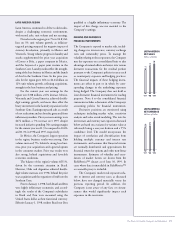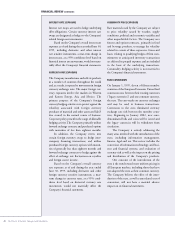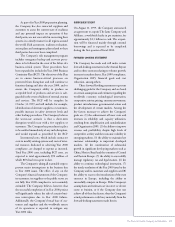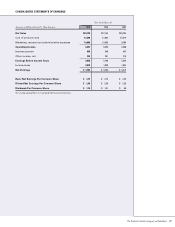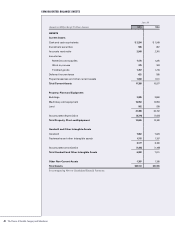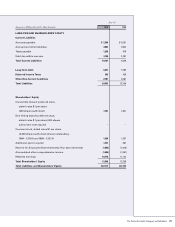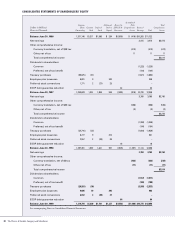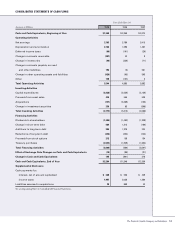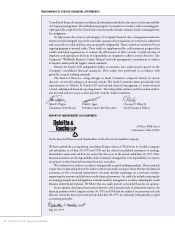Proctor and Gamble 1999 Annual Report Download - page 26
Download and view the complete annual report
Please find page 26 of the 1999 Proctor and Gamble annual report below. You can navigate through the pages in the report by either clicking on the pages listed below, or by using the keyword search tool below to find specific information within the annual report.
FINANCIAL REVIEW (CONTINUED)
22
The Procter & Gamble Company and Subsidiaries
Employee separation charges in 1999 relate to
severance packages for approximately 400 people,
representing primarily administrative employees in
Asia, Europe, Middle East and Africa. The pre-
dominantly voluntary packages are formula-
driven, based on salary levels and past service.
Severance costs related to voluntary separations are
charged to earnings when the employee accepts
the offer in accordance with P&G policy for
such programs. The streamlined work processes
and manufacturing consolidations driven by
the Organization 2005 program will result in
additional separations of approximately 9,000
employees through fiscal 2001, representing
approximately $530 million of costs over that
period. Net enrollment is expected to decline by
approximately 75% of total separations, as some
terminations will be partially offset through
increased enrollment at remaining sites. Of total
separations expected through fiscal 2001, approx-
imately half will take place in manufacturing with
the balance in administrative functions. Separation
costs related to manufacturing employees are
included in cost of products sold, while those for
administrative employees are reported in market-
ing, research and administrative expenses.
Asset write-downs relate primarily to manu-
facturing assets that, based on a shift in global
strategy enabled by Organization 2005, as well as
demand trends below expectation, now are
expected to operate at levels significantly below
their capacity. Because the projected cash flows
from such assets over their remaining useful lives
now are estimated to be less than their current
carrying values, the assets were written down to
estimated fair value as determined using dis-
counted cash flows. The balance of the asset
write-downs relate to “assets held for disposal”
and represent excess capacity that is in the process
of being removed from service and disposed.
Such assets were written down to the lower of
their current carrying basis or amounts expected
to be realized upon disposal, less related disposal
costs. Disposal costs are not expected to be signif-
icant. Asset write-downs charged to earnings in
1999 will not have a significant impact on future
depreciation charges.
The charges for accelerated depreciation
relate to long-lived assets that will be taken out of
service prior to the end of their normal service
period due to manufacturing consolidations,
technology standardization and closures that will
occur primarily over the next three years as a result
of the Organization 2005 program. The Company
has changed the estimated useful lives of such
assets, resulting in an acceleration of depreciation.
The underlying plant closures and consolidations
will impact all regions and product segments.
These planned plant closures and consolidations
will not be executed immediately due to either
capacity or logistics constraints. Accelerated depre-
ciation charges for fiscal years 2000 and 2001 are
expected to amount to approximately $390 million
before tax and $170 million before tax, respectively.
Other costs include primarily relocation and
training costs, as well as other Organization 2005-
related expenses. Such costs are expensed as
incurred. Other costs currently are estimated at
$220 million before tax and $170 million before
tax for fiscal years 2000 and 2001, respectively,
reflecting increased activity related to the transition
to Global Business Services.
YEAR 2000
The Company has substantially completed its
program to address the possible exposures related
to the Year 2000 impact on its computer
systems. Progress against detailed plans is moni-
tored and reported to management and the Audit
Committee of the Board of Directors on a regu-
lar basis. Modification or replacement of critical
financial, information and operational systems,
including equipment with embedded micro-
processors, have been substantially completed.
Testing and certification of critical systems,
which includes review of documented remedia-
tion work and test results by technical experts,
key users and a central project team, is expected to
be successfully completed by September 30, 1999.
In addition, the Company’s internal controls
organization has reviewed the testing and certifi-
cation process and observed the testing of
selected critical systems in each region.
Critical Systems Description
Year 2000 % of Applications Complete
Actual Actual Planned
June 1998 June 1999 Sept. 1999
Critical manufacturing,
operating and
control systems 44.0% 99.0% 100.0%
All other critical systems 56.0% 99.6% 100.0%









